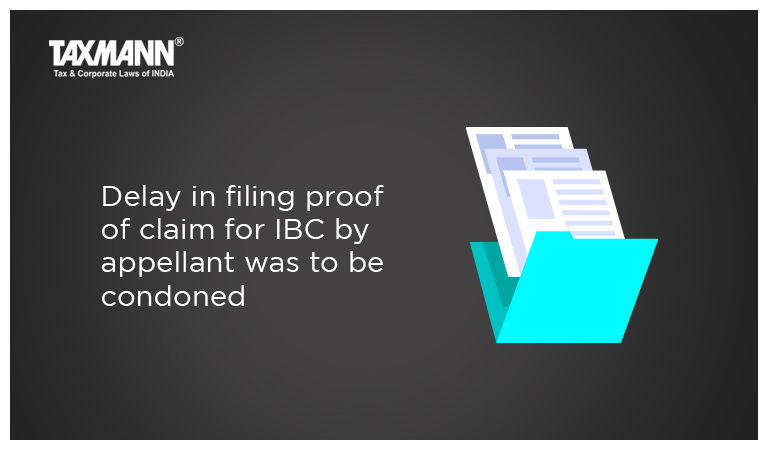Delay in filing proof of claim for IBC by appellant was to be condoned
- Blog|News|Insolvency and Bankruptcy Code|
- 2 Min Read
- By Taxmann
- |
- Last Updated on 5 August, 2022

Case Details: Punjab National Bank v. Animesh Mukhopadhyay - [2022] 140 taxmann.com 583 (NCLAT-New Delhi)
Judiciary and Counsel Details
-
- Justice Ashok Bhushan, Chairperson, Dr Alok Srivastava & Ms Shreesha Merla, Member
- Rajesh Kumar Gautam, Anant Gautam & Nipun Sharma, Advs. for the Appellant.
- Rishabh Banerjee, Pranay Agarwal, Ms Ankita Baid, Advs., Animesh Mukhopadhyay, RP, Jishnu Saha, Sr. Adv., Ishaan Saha, Sananda Ganguli, Om Narayan Rai & Mohit Seth, Advs. for the Respondent.
Facts of the Case
In the instant case, the corporate insolvency resolution process (CIRP) was initiated against the corporate debtor and the appellant filed its claim before Resolution Professional (RP) and submitted proof of claim. The RP rejected a claim of the appellant on the ground that proof of claim was submitted eight days after the expiry of 270 days of the CIRP period.
The appellant filed an application before the Adjudicating Authority (NCLT) seeking direction to RP for verification of its claim and giving it a rightful place in CoC. Meanwhile, an application was filed by a prospective resolution applicant before the NCLT.
The NCLT, without considering the application of the appellant, passed impugned order directing CoC existing as on date to consider the resolution plan filed by the resolution applicant while allowing exclusion of 245 days from the CIRP period.
Thereafter, an appeal was made to the National Company Law Appellate Tribunal (NCLAT) against the order passed by the National Company Law Tribunal (NCLT).
The appellant contended that the impugned order passed by the NCLT excluded its rightful position in the CoC as its claim was not considered by the RP and the application filed by the appellant to condone the delay in submission of the document in support of its claim was not decided in time by the NCLT.
It was noted that certain yardsticks of natural justice were considered by the NCLT in relation to the application of prospective resolution applicant regarding consideration of its proposed resolution plan and exclusion of time period from the CIRP period, however, no such opportunity was given to the appellant who had been pursuing matter diligently.
NCLAT Held
The NCLAT held that since the exclusion of 245 days had been granted in the CIRP period, the benefit of condonation of delay should have also been available to the appellant. Therefore, a delay of 8 days in filing proof of claim by the appellant was to be condoned and RP was to be directed to consider the proof of claim of the appellant.
List of Cases Reviewed
-
- Order of NCLT (Kolkata Bench) in I.A No. 922/KB/2021 in CP (IB) No. 159/KB/2019, dated 14-12-2021 (para 28) reversed.
- Edukanti Kistamma v. S. Venkatareddy [2010] 1 SCC 756 (para 24) distinguished.
List of Cases Referred to
-
- Edukanti Kistamma v. S. Venkatareddy [2010] 1 SCC 756 (para 10)
- Dy. Commissioner v. Kiran Shah [CA (AT) (Ins.) No. 328 of 2021] (para 25).
Disclaimer: The content/information published on the website is only for general information of the user and shall not be construed as legal advice. While the Taxmann has exercised reasonable efforts to ensure the veracity of information/content published, Taxmann shall be under no liability in any manner whatsoever for incorrect information, if any.

Taxmann Publications has a dedicated in-house Research & Editorial Team. This team consists of a team of Chartered Accountants, Company Secretaries, and Lawyers. This team works under the guidance and supervision of editor-in-chief Mr Rakesh Bhargava.
The Research and Editorial Team is responsible for developing reliable and accurate content for the readers. The team follows the six-sigma approach to achieve the benchmark of zero error in its publications and research platforms. The team ensures that the following publication guidelines are thoroughly followed while developing the content:
- The statutory material is obtained only from the authorized and reliable sources
- All the latest developments in the judicial and legislative fields are covered
- Prepare the analytical write-ups on current, controversial, and important issues to help the readers to understand the concept and its implications
- Every content published by Taxmann is complete, accurate and lucid
- All evidence-based statements are supported with proper reference to Section, Circular No., Notification No. or citations
- The golden rules of grammar, style and consistency are thoroughly followed
- Font and size that’s easy to read and remain consistent across all imprint and digital publications are applied





